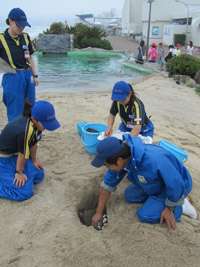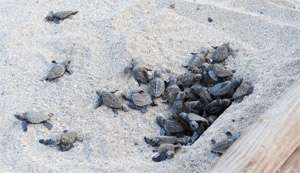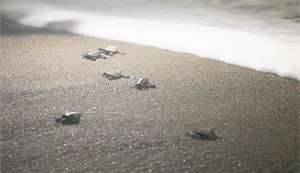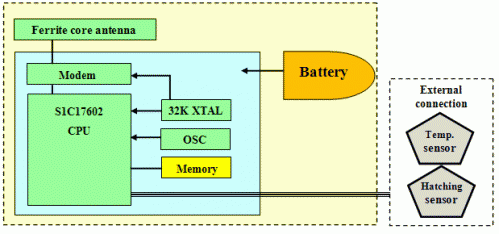Report on Loggerhead Sea Turtle Protection Project

Epson has been working with Kamogawa Sea World and the Japanese government since June 2010 in a project to help protect and preserve endangered loggerhead sea turtles. Epson developed two new types of wireless sensor modules for this project. One is a temperature sensor module that measures the temperature of the sand at 10-cm intervals between a depth of 10 cm and 50 cm. The other is a hatching sensor module that detects when buried eggs begin to hatch.
Temperatures are automatically measured every 30 minutes. The temperature data is stored in memory within the sensor modules. Hatching is detected with miniature sensor placed above the eggs. The date and time that the hatchlings touch the sensor are recorded in memory within the sensor module.
Temperature and hatching data are automatically sent and received wirelessly five times a day from sensor modules buried in the sand at Turtle Beach, an artificial beach inside Kamogawa Sea World. These modules are part of a new automated wireless system that allows data to be collected remotely without entering and disturbing the nesting site. This system reduces the work load on Kamogawa Sea World personnel while also minimizing the impact on hatchlings still in the sand. Since measuring equipment cannot be permanently installed on the beaches of Kamogawa's Tojo and Maehara coastlines, Kamogawa Sea World personnel go around by bicycle or on foot once a day to collect data with an instrument known as an orange box.
-

Hatchlings on the beach. -

Hatchlings headed for the ocean.
What sets Epson's wireless communications technology apart from the pack is that it enables data signals to be sent and received from devices in the ground, sand, or water. This technology makes it possible for researchers to collect the detailed temperature data they need to understand egg development and to determine the date and time eggs hatched, without having to disturb the nesting environment.
The sand at Turtle Beach and along the natural coastline where studies are conducted is hot and humid under the summer sun and coastal rainfall. Sensor modules buried in these conditions have to be robust enough to maintain accuracy over long periods of time under changing environmental conditions. For this reason, the temperature sensors are placed in a watertight case that Epson created this year by borrowing manufacturing technology from its watch division.

In fiscal 2011, Epson offered technology and human support to a joint research project between Kamogawa Sea World and the Tokyo University of Agriculture to study the relationship between sand temperature, growth conditions, and hatchling gender.
In this project researchers studied the effect that differences in temperature at the top, middle, and bottom of a nest have on hormone levels in the blood. The Tokyo University of Agriculture announced the results of this study in August 2012 at the 18th Conference of the Japanese Society of Zoo and Wildlife Medicine. The detailed temperature data provided by Epson's temperature sensor modules was indispensable to this research.

For 2012, Epson's third season of involvement in the project, Epson developed longer-lasting temperature sensors and more sensitive hatching sensors. The temperature sensors continue to provide stable measurements even after six months buried in the sand under harsh, changeable environmental conditions. The new hatching sensors, more sensitive and accurate than their predecessors, provide more accurate data and increase study efficiency. They are equipped with a pin that detects even very slight movements under the sand as the turtles hatch. Moreover, they use a tilt sensor with a high sensitivity angle to increase sensing accuracy. These improved sensors provide a better rate of detection and more precise data on the time it takes for hatchlings to reach the surface of the sand after breaking out of their shells.
Epson hopes to participate in the Loggerhead Sea Turtle Protection Project on an ongoing basis going forward.
Source: Epson


















